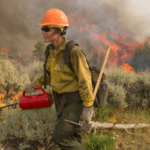
It is hard to miss the #MeToo movement these days. The international movement against sexual harassment and assault is everywhere in conventional and social media as well as water cooler and dinner table conversation. Important in its own right, #MeToo also has been a touchstone for broader conversations about inclusivity, diversity, equity, power dynamics and the challenges of who gets to represent whom in our culture.
These conversations have been taking place within the wildfire world as well. The resignation of United States Forest Service Chief Tony Tooke in March 2018 under allegations of sexual misconduct have highlighted the need for our wildfire communities to build our collective capacity to confront and address these controversial topics. Sexual harassment, sexual misconduct and gender discrimination is known to be widespread in many government agencies including the US Forest Service, National Park Service and US military. The United States is not alone in facing these issues. Canada and Australia report similar trends.
In 2015, an AFE survey with almost 350 respondents revealed that
- 32% reported observing incidents of sexual harassment in the workplace and 24% experienced it directly,
- 54% reported observing gender discrimination of others in the workplace and 44% reported experiencing it,
- 64% of respondents who experienced sexual harassment, and
- 60% who experienced gender discrimination did not report it.
And it is not just about women. While women make up the majority of the cases associated with sexual assault and harassment, a significant minority of reported cases are from men who also are affected. And it is not just men who harass or discriminate. Women also play a role, as detailed in Sara Brown’s unflinchingly courageous tale of her own experience as a wildland fire fighter, which can be viewed here: https://www.youtube.com/watch?v=302W8aKQknA&feature=youtu.be
Just so we are clear, sexual harassment is when conduct of a sexual nature in a workplace or social situation affects an individual’s employment or work performance. It can take the form of unwelcomed sexual advances, requests for sexual favors or obscene remarks. Gender discrimination is when someone is treated unfairly because of their gender. It can manifest in unequal pay and/or inequitable opportunity for promotion, benefits or other professional rewards. In some cases, discrimination can be deeply embedded in a given institutional culture and people may be unaware that they are participating in discriminatory practices.
In many ways dealing with sexual harassment and assault are easier for us to find agreement on—everyone deserves a safe work space. It is the subtle forms of discrimination, the ones that manifest in sometimes visible but more often invisible ways that are harder for us to confront and address. How do we find ways to make more people feel welcomed and valued?
At the Fire Continuum Conference May 21-24, 2018 in Missoula, Montana the topic was “Preparing for the Future of Wildland Fire.” Part of this future calls for a more inclusive and diverse approach to how the International Association of Wildland Fire (IAWF) and the Association for Fire Ecology (AFE), both co-sponsors of the conference, do business.
We, Karin Riley, the Vice President of Association for Fire Ecology and Toddi Steelman, the Vice President of the International Association of Wildland Fire, addressed the audience in a plenary session to announce that our respective Associations would be responding to an inclusivity and diversity challenge posed to us by our peers. In early 2018, IAWF and AFE received a letter signed by over 50 people ranging from research to land management to the non-profit sector in at least three countries. The letter stated that, “Over the past several AFE and IAWF conferences, a disproportionate number of plenary speaking roles have been awarded to non-minority male scientists.”
After careful review of the complaints, IAWF and AFE both passed resolutions stating that diversity and inclusivity across gender and a variety of ethnicities shall be a priority in all that the two organizations do, including leadership, membership, programs, and activities including recruiting Board members, Associate Journal Editors, and reviewers.
Our aspirations for this initiative are to strive to create a fire community where all members feel safe and welcomed and valued. This will mean promoting diversity and inclusivity in all our Association activities, monitoring our progress, reporting on it publicly, rooting out structural barriers that inhibit progress and holding ourselves accountable for continuous improvement. Our Associations affirm to increase representation in ideas, viewpoints, gender, sexual orientation, culture, race, age and experience to ensure equal opportunities to participate and contribute. We are committed to doing better.
We also want to be clear about a few things that this initiative is not. It’s not about blaming any one group or person for the situation. It is about all of us coming together to shine a light on how conscious and unconscious biases harm our profession. It is about ensuring that differences are embraced, all community members are welcomed, included, and valued, and that we have participation from the widest and most diverse range of wildfire professionals possible.
As we move forward, it is important to recognize that inclusivity, diversity and equality are not ends unto themselves. They are a means to a better society at large. We do not value diversity, equity and inclusivity for their own sake. We value them because they make us better in what we do. Greater equity in management will make for better wildfire management. Greater diversity in science will make for better wildfire science. Greater inclusivity in all we practice will make us better wildfire practitioners.
— Toddi Steelman, Vice President, International Association of Wildland Fire
— Karin Riley, Vice President, Association of Fire Ecology
Links
- IAWF Diversity and Inclusion Policy:
https://www.iawfonline.org/wp-content/uploads/2018/05/IAWF-Diversity-and-Inclusion-Policy.pdf
- AFE Position Paper on Sexual Harassment and Gender Discrimination in Wildland Fire Management: https://fireecology.org/resources/Pictures/AFE%202016%20position%20paper%20on%20discrimination%20final%2011-25.pdf
